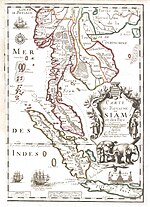Wen Dan (文單) | |
|---|---|
| 7th century–8th century | |
| Capital | Kantharawichai[1] |
| Religion | Buddhism |
| Historical era | 7th-8th century |
• Established | 7th century |
• Disestablished | 8th century |
| History of Thailand |
|---|
 |
|
|
Wén Dān (Chinese: 文單; Thai: เหวินตัน) was a group of ancient Mon political entities that existed around the 7th–8th centuries CE in the interior of mainland Southeast Asia scattered around the central Mekong Valley in the present-day northeast Thailand.[1][2][3] It was mentioned in the Chinese annals of the Tang period (618-907 AD) as a dependency on the trans-Mekong trade route from the ancient city of Chiaochih (jiāo zhǐ 交趾; Giao chỉ; near the present-day Vinh of Vietnam) to India.[1]: 25–72 Wen Dan sent representatives to China in 656 – 661, 717, 753, 771, and 798.[1][4]
Initially, Wen Dan was believed to be either Vientiane,[1][2] or the capital of the Land Chenla (Po-Lou),[5]: 16 but according to the location given in the annals as well as archaeological evidence, it is supposed to be in Chi River basin,[1][2] centered in Kantharawichai, with Mueang Fa Daet Song Yang as outer center and Champasri (จัมปาศรี; in present Na Dun district) as the vassal.[1] Several historical evidences supports the connection between Wen Dan and Si Thep in central Thailand.[4]: 91–92
According to the Dvaravati Buddhist boundary stones (Bai sema) dated the 8th century found on Mt. Kulen, Woodward (2003) proposes that Wen Dan once controlled the Angkor region before Jayavarman II proclaimed the independence of the Kambujadesa from Java in 802.[4]: 87–88 Jayavarman II probably either defeated Wen Dan and then moved the capital from Indrapura to Yaśodharapura in the north,[4]: 87 or formed ally with the communities in Mun and Chi watersheds to against Si Thep in the west.[4]: 93
- ^ a b c d e f g Tatsuo Hoshino (2002). "Wen Dan and its neighbours: the central Mekong Valley in the seventh and eighth centuries". In Mayoury Ngaosrivathana; Kennon Breazeale (eds.). Breaking new ground in Lao history: essays on the seventh to twentieth centuries. Chiang Mai: Silkworm Books. Archived from the original on 9 April 2024.
- ^ a b c John N. Miksic; Goh Geok Yian (2017). Ancient Southeast Asia. Routledge. p. 654. ISBN 9780415735544.
- ^ Cite error: The named reference
asianwas invoked but never defined (see the help page). - ^ a b c d e Hiram Woodward (2023). "Dvaravati, Si Thep, and Wendan". Archived from the original on 15 October 2022.
- ^ Ferlus, Michel (2012). "Linguistic evidence of the trans-peninsular trade route from North Vietnam to the Gulf of Thailand (3rd-8th centuries). Mon-Khmer Studies, Michel FERLUS" (PDF). Archived from the original (PDF) on 10 January 2020. Retrieved 20 March 2021.
© MMXXIII Rich X Search. We shall prevail. All rights reserved. Rich X Search
